| Article ID | Journal | Published Year | Pages | File Type |
|---|---|---|---|---|
| 2791071 | Zoology | 2013 | 8 Pages |
The suspension-feeding cichlids Oreochromis aureus (blue tilapia) and Oreochromis esculentus (ngege tilapia) are able to selectively retain small food particles. The gill rakers and microbranchiospines of these species have been assumed to function as filters. However, surgical removal of these oral structures, which also removed associated mucus, did not significantly affect the total number of 11–200 μm particles ingested by the fish. This result supports the hypothesis that the branchial arch surfaces themselves play an important role in crossflow filtration. Both species selectively retained microspheres greater than 50 μm with gill rakers and microbranchiospines intact as well as removed, demonstrating that neither these structures nor mucus are necessary for size selectivity to occur during biological crossflow filtration. After removal of the gill rakers and microbranchiospines, O. esculentus retained significantly more microspheres 51–70 μm in diameter and fewer 91–130 μm microspheres compared to retention with intact structures, but the particle size selectivity of O. aureus was not affected significantly. These results support conclusions from previous computational fluid dynamics simulations indicating that particle size can have marked effects on particle trajectory and retention inside the fish oropharyngeal cavity during crossflow filtration. The substantial inter-individual variability in particle retention by suspension-feeding fish is an unexplored area of research with the potential to increase our understanding of the factors influencing particle retention during biological filtration.
